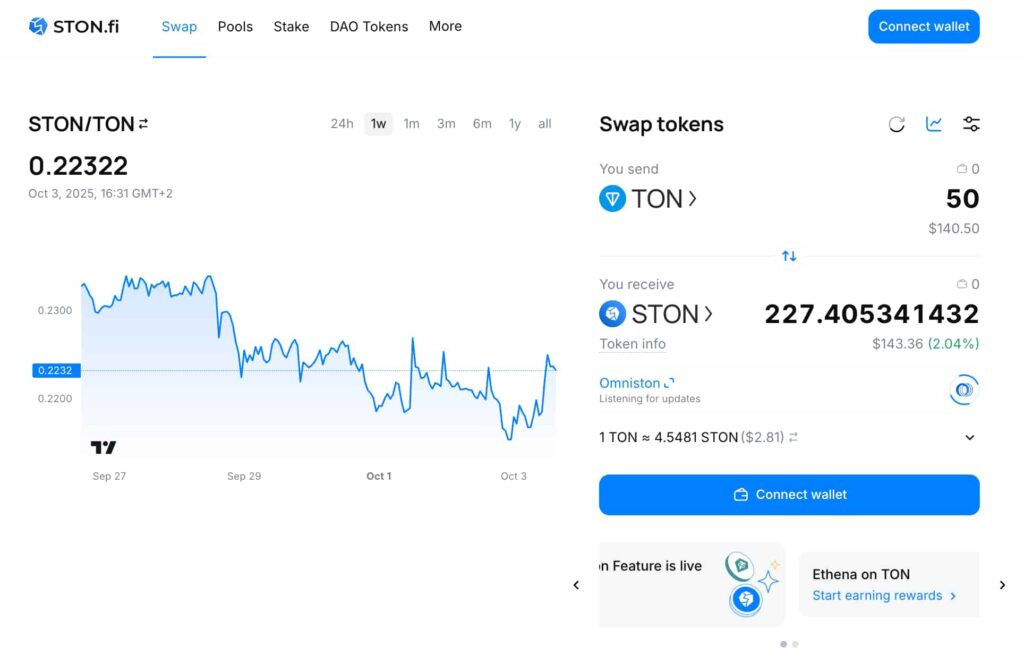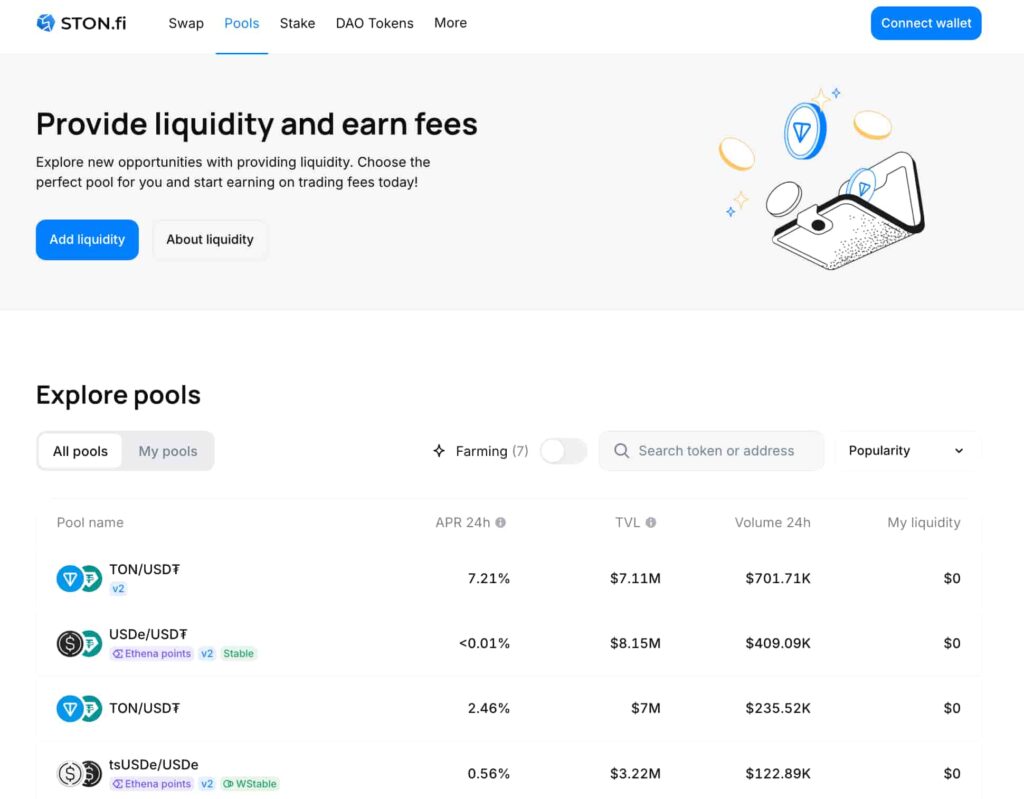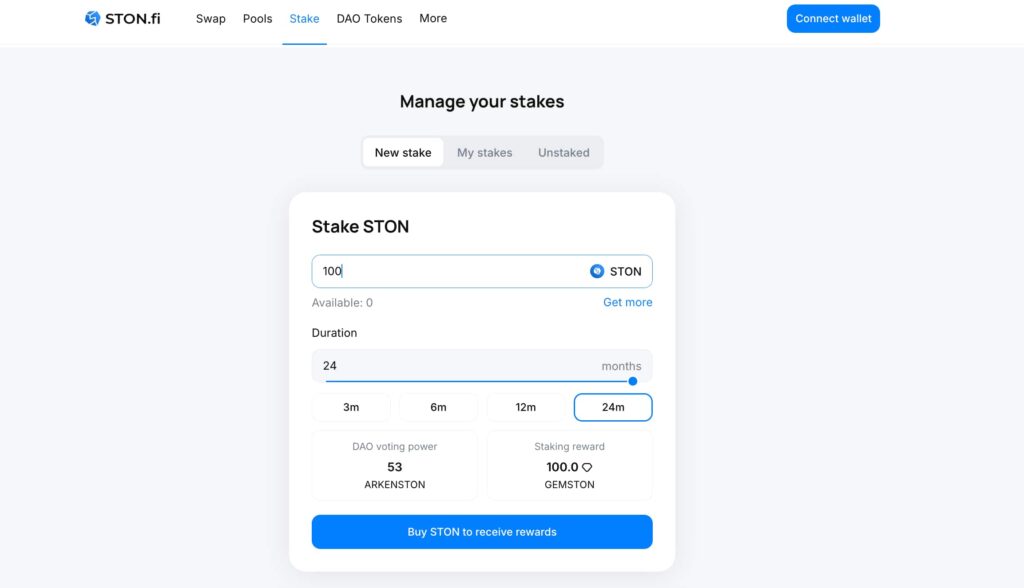Among the growing set of TON-based protocols, STON.fi has emerged as a flagship AMM (Automated Market Maker), combining simple token swaps, liquidity provision, staking, and other community-driven DeFi activities into one platform.
This guide explains what STON.fi is, how to use it to swap tokens, provide liquidity, and stake the STON token.
What is STON.fi?

STON.fi is a DeFi protocol built on The Open Network (TON). It lets users swap TON-based tokens instantly, provide liquidity to get rewards from swap fees, and stake the STON token directly from their TON wallet.
The platform uses an automated market maker (AMM), where transactions happen through liquidity pools instead of traditional order books. This design keeps operations fast, transparent, and always available.
STON.fi is simple to use and fully non-custodial. Users keep control of their funds at all times, with low fees, quick confirmations, and all transactions processed on-chain.
STON.fi also includes a liquidity aggregation protocol, Omniston, that scans multiple TON-based DEXs to find and execute the best available price for each swap.
Swapping tokens on STON.fi

Swapping on STON.fi is one of the simplest ways to swap one token for another on TON blockchain. Here’s how it works:
- Within the Swap tab of the STON.fi app, users select the token they want to swap — for example, TON — and the token they wish to receive, such as STON.
- After entering the amount to swap, the platform automatically calculates how much will be received, taking into account fees and slippage.
- To cover network fees, users should keep at least 0.4 TON in their wallets; typically, only 0.05–0.08 TON is spent, and any unused portion is refunded.
- Once the details are confirmed, the transaction is completed directly through the connected TON wallet, finalizing the swap.
Within seconds, your new tokens will appear in your wallet, ready to use.
What sets STON.fi apart from other swap dApps is its focus on liquidity aggregation and its vision for cross-chain interoperability. While maintaining a clean, user-friendly interface, STON.fi’s underlying architecture continuously scans multiple TON-based liquidity sources to route each transaction through the most efficient liquidity path. This design ensures users always receive optimal pricing, with complex routing handled seamlessly in the background.
Providing liquidity
Beyond simple swaps, users can take part in liquidity provision and receive a share of swap fees.
Liquidity pools hold reserves of two tokens that users swap against. On STON.fi, a liquidity provider transfers an equal value of both tokens (not equal quantities), receives LP tokens representing the share, and gets a cut of swap fees. Users can withdraw by redeeming LP tokens at any time.
Where do pool tokens come from, and how are fees paid out?

Adding liquidity involves the following steps:
- Open the Pools tab, a user picks a pair (e.g., STON/TON), and clicks Add liquidity;
- A user provides equal value of each token, with the interface automatically balancing the amounts;
- For v2 pools, the Arbitrary Provision feature allows a user to provide tokens in any ratio;
- After confirming the transaction in a connected wallet, LP tokens are issued within seconds, representing the user’s position and granting a proportional share of swaps fees.
Staking STON
Staking on STON.fi allows users to lock their STON tokens in a smart contract and receive rewards in return. Unlike liquidity provision, where you supply pairs of assets to a pool, staking is a single-token commitment designed to align participants with the long-term growth of the protocol.
When you stake STON, you receive two tokens:
- ARKENSTON: a soulbound NFT that is permanently tied to your wallet. It cannot be sold or transferred. ARKENSTON acts as your entry ticket into the STON.fi DAO, the governance community that will vote on proposals and decide on the protocol’s future direction;
- GEMSTON: a community token within the STON.fi ecosystem. GEMSTON is available on STON.fi and a number of exchanges, and its role will ultimately be determined by DAO governance. A built-in calculator in the staking interface lets you preview how much GEMSTON you will receive immediately after staking.
To stake, users head to the Stake tab on the STON.fi app, select how much STON they want to lock, and choose the staking duration. Rewards are tied to both the amount staked and how long the commitment is. Once locked, the tokens cannot be unstaked until the chosen period ends.

This design makes staking less about short-term gains and more about deeper involvement in the protocol, as users gain both governance access and additional incentivisation in return for their commitment.
Is STON.fi safe?
Before using any DeFi protocol it’s worth understanding how it protects users and manages risk. Here’s what the project discloses about its security and compliance posture:
- Audits & monitoring. STON.fi lists a Trail of Bits security review of its v2 smart contracts and notes a completed audit of Omniston escrow contracts. There’s also continuous monitoring via CertiK Skynet and a public HackenProof bug bounty for the v2 contracts. Audits don’t eliminate risk, but they’re meaningful independent checks;
- Verified smart contracts. All swaps, liquidity operations, and staking actions are executed directly on-chain through open-source, verified smart contracts, meaning users interact with code deployed on the TON blockchain rather than any centralized system;
- Non-custodial design. The homepage and docs emphasize that STON.fi does not take custody of user funds; swaps settle on-chain from your wallet, and the interface does not ask for personal information;
- KYC/AML stance. The whitepaper frames STON.fi as a zero-trust AMM and highlights predictable transaction time “(no KYC)” as part of its protocol design. This is an architectural statement (and not legal advice); interfaces may still adapt to local laws;
- Public metrics. For activity data such as TVL, fees, and DEX volume, third-party dashboards like DeFiLlama maintain an up-to-date STON.fi page. External analytics aren’t audits, but they help you gauge adoption and revenue trends. As of October 2025, STON.fi ranks as the №1 platform on TON by unique active wallets, processing over $6.5 billion in total volume. Around 70% of TON traders already use the protocol, which has attracted more than 5.6 million users and facilitated over 29 million operations since launch.
STON.fi fees
STON.fi uses a per-pool configurable fee model, meaning each liquidity pool can have its own fee settings.
- Default fee: 0.3% per swap — of which 0.2% goes to liquidity providers (LPs) and 0.1% goes to the STON.fi protocol treasury;
- Configurable range: The total fee and split can be adjusted by the protocol administrator within a 0%–1% range;
- Accrual: LP rewards accumulate in real time and are distributed pro-rata to each provider based on their share of the pool’s total liquidity;
- Transparency: Each pool’s current fee rate is displayed directly in the app, and developers can retrieve fee data via the public DEX API or SDK.
Conclusion
STON.fi is an AMM and foundational DeFi protocol on the TON blockchain, combining fast token swaps, liquidity aggregation, and staking within a single platform. Powered by Omniston’s liquidity aggregation and multi-DEX routing, it provides users with non-custodial access to the expanding on-chain economy powered by TON.
Its main appeal lies in speed, simplicity, and low fees, with a roadmap focused on deeper aggregation and cross-chain functionality that avoids custodial bridges. With this vision taking shape, STON.fi is positioned to solidify its role as a core DeFi gateway within the TON ecosystem.
Disclaimer: The content on this site should not be considered investment advice. Investing is speculative. When investing, your capital is at risk.
FAQs about STON.fi
What is STON.fi?
Do I need KYC to use STON.fi?
The protocol positions itself as non-custodial. As a result, KYC regulations do not apply.




